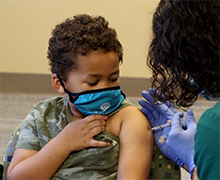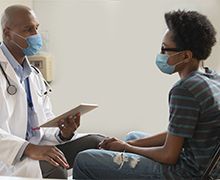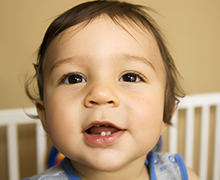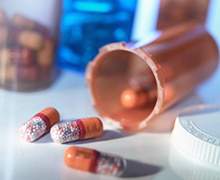Winter 2022
What to Know About the COVID-19 Vaccine for Kids
 Children age 5 and older are now eligible to receive the Pfizer COVID-19 vaccine. It’s given as two shots, 21 days apart. The vaccine for ages 5 to 11 is a smaller dose than what’s used for adolescents and adults — about one-third the amount. (For children ages 6 months to under 5 years, clinical trials are now underway.)
Children age 5 and older are now eligible to receive the Pfizer COVID-19 vaccine. It’s given as two shots, 21 days apart. The vaccine for ages 5 to 11 is a smaller dose than what’s used for adolescents and adults — about one-third the amount. (For children ages 6 months to under 5 years, clinical trials are now underway.)
The COVID-19 vaccine for kids has proven to be both safe and effective; everyone who’s eligible should get it as soon as possible. The vaccine greatly reduces the chances of getting COVID, and it does an outstanding job of preventing severe illness and hospitalization. Even those who have already had COVID-19 infection need the vaccine to help protect them from getting it again. If you have any questions about the COVID-19 vaccine (or any childhood vaccine) be sure to ask your child’s doctor.
Where can you get the vaccine for your child? Ask their regular healthcare provider or visit Washington’s vaccine locator to find locations near you. And remember that COVID-19 vaccines are free, whether or not you have health insurance.
Also keep in mind that the pandemic has caused many families to fall behind on their routine vaccinations. Ask your doctor to check if your child is up to date on their other shots, including the seasonal flu vaccine. It’s safe for kids to get other vaccines during the same visit as the COVID-19 vaccine.
Before any vaccine shot, you can help your child feel as prepared and relaxed as possible. Tell them what’s going to happen. Don’t tell them it won’t hurt or ask them not to cry. Work with the medical staff to offer your child choices such as where they sit, which arm they’ll get the shot in and whether they want to watch or turn their head away from the needle. Praise them for staying still and being cooperative. And remind them that the definition of bravery is being afraid and doing it anyway!
Vaccines are a safe and effective way to prevent diseases that can make children very sick and cause lifelong disabilities — and even death. Getting vaccinated against COVID-19 and other diseases helps protect your child, your family and the entire community
Healthcare Providers and Suicide Screenings
 Suicide is now the second-leading cause of death for children and adolescents in the United States. The increase in youth suicides is one reason we’re in a national youth mental-health emergency.
Suicide is now the second-leading cause of death for children and adolescents in the United States. The increase in youth suicides is one reason we’re in a national youth mental-health emergency.
Today, healthcare providers are routinely screening young patients for the risk of suicide — even when the reason for the visit is not mental-health related. At Seattle Children’s locations, we now ask all patients 10 and older if they have suicidal thoughts.
Remember, asking about suicide does not cause suicide or put it in a child’s head. These screenings are saving young lives.
Learn how to recognize when someone may be at risk of suicide and how to connect them with immediate help. Visit our mental health resource hub for more on youth mental health.
Controlling Cholesterol for Heart Health
 In the past, cholesterol was considered a concern for adults. But it’s now understood that children with unhealthy levels are at greater risk for heart disease and strokes in adulthood. You can help protect your child’s heart health now and in the future by keeping their cholesterol in check — with smart food choices and plenty of exercise.
In the past, cholesterol was considered a concern for adults. But it’s now understood that children with unhealthy levels are at greater risk for heart disease and strokes in adulthood. You can help protect your child’s heart health now and in the future by keeping their cholesterol in check — with smart food choices and plenty of exercise.
What is cholesterol? It’s a substance made by the liver that’s needed to make healthy cells, hormones and vitamin D. However, when we eat too many foods that are high in saturated fat and trans fat, our livers can produce more cholesterol than we need, including a harmful type that can build up on the walls of our arteries and lead to problems.
All kids ages 9 to 11 should have their cholesterol checked; you may need to request this screening. If your child’s doctor is concerned, they will likely recommend some simple lifestyle changes centered on diet and exercise. This can be a golden opportunity for the entire family to adopt some heart-healthy habits to last a lifetime. Get started with indoor active play ideas.
Say Yes to Positive Reinforcement
 The new year is an ideal time to renew our commitment to using positive reinforcement with our kids. It’s a simple, logical tool that teaches and strengthens the behaviors we want to see. Using positive reinforcement takes a bit of practice at first. Soon, it becomes a habit that feels easy and natural. Think of it as ‘catching your child in the act’ of doing good things — especially if it’s something they’re struggling with.
The new year is an ideal time to renew our commitment to using positive reinforcement with our kids. It’s a simple, logical tool that teaches and strengthens the behaviors we want to see. Using positive reinforcement takes a bit of practice at first. Soon, it becomes a habit that feels easy and natural. Think of it as ‘catching your child in the act’ of doing good things — especially if it’s something they’re struggling with.
Positive reinforcement includes specific and immediate praise. It might sound like: “Your bedroom looks amazing, thank you so much for putting all your clothes and toys away!” or “Thank you for trying all the different foods on your plate without me asking.” or “I appreciate how patient and generous you’re being with your little sister right now.”
Positive reinforcement also uses simple and immediate rewards for good behaviors. A reward might be letting your child choose what song to play in the car — right after they quickly and quietly buckle up. Or it could be letting them choose a treat for their sack lunch — right after they take out the garbage without grumbling. (It’s important to understand that rewards are not bribes. Bribing happens when a child is not doing what’s desired, and we try to entice them to
change their bad behavior: like buying them candy in the supermarket line so they’ll stop screaming. Bribes don’t work well and can actually make behavior problems worse.)
Positive reinforcement shines a spotlight on a child’s strengths and good habits. It’s a popular parenting method because it really works, and it makes everyone feel great!
Prevent Tooth Decay in Babies
 Even though baby teeth are temporary, it’s important to protect babies and toddlers against tooth decay.
Even though baby teeth are temporary, it’s important to protect babies and toddlers against tooth decay.
Avoid putting your baby to bed with a bottle and, if breastfeeding, remove your breast as they fall asleep — so un-swallowed milk doesn’t sit in their mouth. For both bottle-fed and breastfed infants, wipe their gums after feeding with a clean, damp gauze pad or washcloth. Don’t fill bottles with juice or sugary drinks. And avoid sharing your mouth’s bacteria with your child: Keep their feeding spoon and pacifier out of your mouth.
Once baby’s teeth come in, start brushing twice a day with a soft toothbrush and a grain-of-rice sized amount of fluoride toothpaste. Have your baby’s mouth checked by their doctor or a dentist by age 1.
Learn more about dental health for your child.
Dressing for Winter Outdoor Play
 Your child’s body needs to get moving with plenty of outdoor play, even during chilly winter weather.
Your child’s body needs to get moving with plenty of outdoor play, even during chilly winter weather.
Since kids get cold faster than adults, it’s important to dress them in layers. Start with a close-fitting bottom layer made of material that wicks away moisture, such as nylon or silk. (Avoid cotton, which absorbs moisture.) Add comfortable layers that allow your child to move freely, and top with waterproof outerwear if the weather is wet.
Don’t forget a warm hat, scarf or neck gaiter, gloves or mittens, socks and nonskid boots. Finally, protect their eyes and skin with sunglasses or goggles, plus sunscreen and lip balm. Check on your child often and swap out their wet items with gear that’s warm and dry.
Learn more about winter safety.
Medicine Safety for Young Kids
 When it comes to medicine safety, we must always have several safeguards in place.
When it comes to medicine safety, we must always have several safeguards in place.
- Always use child-resistant containers, but keep in mind they are not childproof; even a very young child may be able to open them.
- Always store medicines out of sight and reach of children — and ideally locked away. Medicines kept in purses and backpacks are a common source of poisoning for young kids.
- Keep medicines in their original, labeled packages; the risk of poisoning goes up when they’re put into another container.
- Never call medicine ‘candy’ to entice a child to take it; it’s dangerously confusing.
- Be sure that grandparents and other caregivers follow these safeguards, too.
The Washington Poison Center offers more medicine safety tips.
Quick Tip
If you think your child or teen may have a concussion, remove them from play and have them seen by a healthcare provider who is experienced in evaluating for concussion. Learn more from the Seattle Sports Concussion Program.


